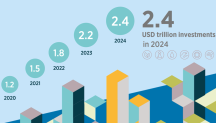

Innovation Will Drive the Energy Transition
Newsletter
As countries around the world shape their plans to build back better in the wake of the coronavirus pandemic, they have a chance to create significant private sector business opportunities by accelerating the global energy transition.
IRENA’s 1.5°C decarbonisation pathway, released last week, shows that investments in the transition need to be scaled up by around USD 5 trillion each year until 2050 to meet the ambitions of the Paris Agreement.
The technologies to achieve this already exist; but systemic innovation is urgently needed to integrate them into new market structures and regulations, business models, and energy system operations. To achieve our climate targets, therefore, we will need to prioritise certain innovations in key areas:
The share of renewable sources in primary energy will need to reach 74% – representing an eight-fold increase from that of recent years. In particular, use of renewables in transport and heating must be accelerated.
Renewable power generation must increase by around 800 GW each year, rising from 2,800 GW to 27,000 GW by 2050. At the same time, we must prioritise the phasing out of coal-based power generation.
Electric vehicle (EV) sales must grow from 4% to 100% of all vehicles sold by 2050. Europe is currently leading the way in this area and is also dramatically ramping up battery manufacturing. A parallel roll-out of charging infrastructure is also essential. Securing the minerals and metals needed for batteries and other transition technologies is a critical issue, and innovation can play a role in markedly reducing dependency.
Clean hydrogen supply and use must grow five-fold, from 120 metric tonnes (Mt) per year to 613 Mt in 2050, which requires a massive roll-out of renewable power generation and electrolysers for green hydrogen production. Aspects such as industry relocation, and the trading of hydrogen and green commodities, are not yet well understood, but may help in tapping remote renewable energy resources to scale up green hydrogen. IRENA is working with partners such as the World Economic Forum on standards and certifications for green hydrogen and green commodities, as prioritised by IRENA’s Collaborative Framework on Green Hydrogen.
Modern biomass use will need to grow markedly to around one fifth of total final consumption (TFC). Bioenergy combined with CCS (so-called, ‘BECCS’) has a key role to play in removing CO2 from the atmosphere. Biomass will also be important as a feedstock for plastics and other materials; sustainable biomass sourcing will therefore be critical.
Annual energy intensity improvement must rise from 1.2% in recent years to around 3% by 2050. In addition to introducing conventional energy efficiency technologies, the broader adoption of renewable power, more widespread electrification, and the establishment of circular economies are all crucial. Significant structural and behavioural changes are also required, as are synergies with new technologies and advances.
Ultimately, a scenario is not a prediction; and the 2050 objective is not set in stone. Nonetheless, a comparison of 18 recent leading scenarios shows that there is consensus that renewable power, energy efficiency and electrification are at the heart of the energy transition, and that fossil fuel use must decline significantly. But the rate of transition required in this decade is higher than anything we have seen so far.
The 2°C and 1.5°C scenarios feature very similar levels of reliance on renewable power, electrification and energy efficiency; the major difference between them is that the 1.5°C scenario calls for more hydrogen and CCS (notably BECCS), which can be scaled up with the support of systemic innovations.
Any transition will create both winners and losers; not everyone will be willing or able to play their part today. Yet, the direction of travel is clear – enabling frameworks must be put in place to accelerate the energy transition by levelling the playing field for the renewables sector, as well as by creating economically viable business cases for innovative solutions.

Expert Insight by:
Dolf Gielen
Director, IRENA Innovation and Technology Center, IRENA

Expert Insight by:
Ricardo Gorini
Senior Programme Officer-Renewable Energy Roadmaps, IRENA

Expert Insight by:
Gayathri Prakash
Associate Programme Officer, REmap, IRENA
© IRENA 2025
Unless otherwise stated, material in this article may be freely used, shared, copied, reproduced, printed and/or stored, provided that appropriate acknowledgement is given of the author(s) as the source and IRENA as copyright holder.
The findings, interpretations and conclusions expressed herein are those of the author(s) and do not necessarily reflect the opinions of IRENA or all its Members. IRENA does not assume responsibility for the content of this work or guarantee the accuracy of the data included herein. Neither IRENA nor any of its officials, agents, data or other third-party content providers provide a warranty of any kind, either expressed or implied, and they accept no responsibility or liability for any consequence of use of the content or material herein. The mention of specific companies, projects or products does not imply that they are endorsed or recommended, either by IRENA or the author(s). The designations employed and the presentation of material herein do not imply the expression of any opinion on the part of IRENA or the author(s) concerning the legal status of any region, country, territory, city or area or of its authorities, or concerning the delimitation of frontiers or boundaries.




